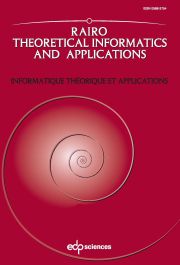Article contents
Arithmetization of the field of realswith exponentiation extended abstract
Published online by Cambridge University Press: 18 January 2008
Abstract
(1) Shepherdson proved that a discrete unitary commutative semi-ring A + satisfies IE 0 (induction scheme restricted to quantifierfree formulas) iff A is integral part of a real closed field; and Berarducci asked about extensions of this criterion when exponentiation is added to the language of rings. Let T range over axiom systems for ordered fields with exponentiation; for three values of T we provide a theory $_{\llcorner} T _{\lrcorner}$  in the language of rings plus exponentiation such that the models (A, expA ) of $_{\llcorner} T _{\lrcorner}$
in the language of rings plus exponentiation such that the models (A, expA ) of $_{\llcorner} T _{\lrcorner}$  are all integral parts A of models M of T with A + closed under expM and expA = expM | A+. Namely T = EXP, the basic theory of real exponential fields; T = EXP+ the Rolle and the intermediate value properties for all 2x-polynomials; and T = Texp , the complete theory of the field of reals with exponentiation.(2) $_{\llcorner}$
are all integral parts A of models M of T with A + closed under expM and expA = expM | A+. Namely T = EXP, the basic theory of real exponential fields; T = EXP+ the Rolle and the intermediate value properties for all 2x-polynomials; and T = Texp , the complete theory of the field of reals with exponentiation.(2) $_{\llcorner}$  Texp $_{\lrcorner}$
Texp $_{\lrcorner}$  is recursively axiomatizable iff Texp is decidable. $_{\llcorner}$
is recursively axiomatizable iff Texp is decidable. $_{\llcorner}$  Texp $_{\lrcorner}$
Texp $_{\lrcorner}$  implies LE0(xy) (least element principle for open formulas in the language <,+,x,-1,xy ) but the reciprocal is an open question. $_{\llcorner}$
implies LE0(xy) (least element principle for open formulas in the language <,+,x,-1,xy ) but the reciprocal is an open question. $_{\llcorner}$  Texp $_{\lrcorner}$
Texp $_{\lrcorner}$  satisfies “provable polytime witnessing”: if $_{\llcorner} $
satisfies “provable polytime witnessing”: if $_{\llcorner} $  Texp $_{\lrcorner}$
Texp $_{\lrcorner}$  proves ∀x∃y : |y| < |x|k)R(x,y) (where $|y|:=_{\llcorner}$
proves ∀x∃y : |y| < |x|k)R(x,y) (where $|y|:=_{\llcorner}$  log(y) $_{\lrcorner}$
log(y) $_{\lrcorner}$  , k < ω and R is an NP relation), then it proves ∀x R(x,ƒ(x)) for some polynomial time function f.(3) We introduce “blunt” axioms for Arithmetics: axioms which do as if every real number was a fraction (or even a dyadic number). The falsity of such a contention in the standard model of the integers does not mean inconsistency; and bluntness has both a heuristic interest and a simplifying effect on many questions – in particular we prove that the blunt version of $_{\llcorner}$
, k < ω and R is an NP relation), then it proves ∀x R(x,ƒ(x)) for some polynomial time function f.(3) We introduce “blunt” axioms for Arithmetics: axioms which do as if every real number was a fraction (or even a dyadic number). The falsity of such a contention in the standard model of the integers does not mean inconsistency; and bluntness has both a heuristic interest and a simplifying effect on many questions – in particular we prove that the blunt version of $_{\llcorner}$  Texp $_{\lrcorner}$
Texp $_{\lrcorner}$  is a conservative extension of $_{\llcorner} $
is a conservative extension of $_{\llcorner} $  Texp $_{\lrcorner}$
Texp $_{\lrcorner}$  for sentences in ∀Δ0(xy ) (universal quantifications of bounded formulas in the language of rings plus xy ). Blunt Arithmetics – which can be extended to a much richer language – could become a useful tool in the non standard approach to discrete geometry, to modelization and to approximate computation with reals.
for sentences in ∀Δ0(xy ) (universal quantifications of bounded formulas in the language of rings plus xy ). Blunt Arithmetics – which can be extended to a much richer language – could become a useful tool in the non standard approach to discrete geometry, to modelization and to approximate computation with reals.
Information
- Type
- Research Article
- Information
- Copyright
- © EDP Sciences, 2007
References
- 2
- Cited by

